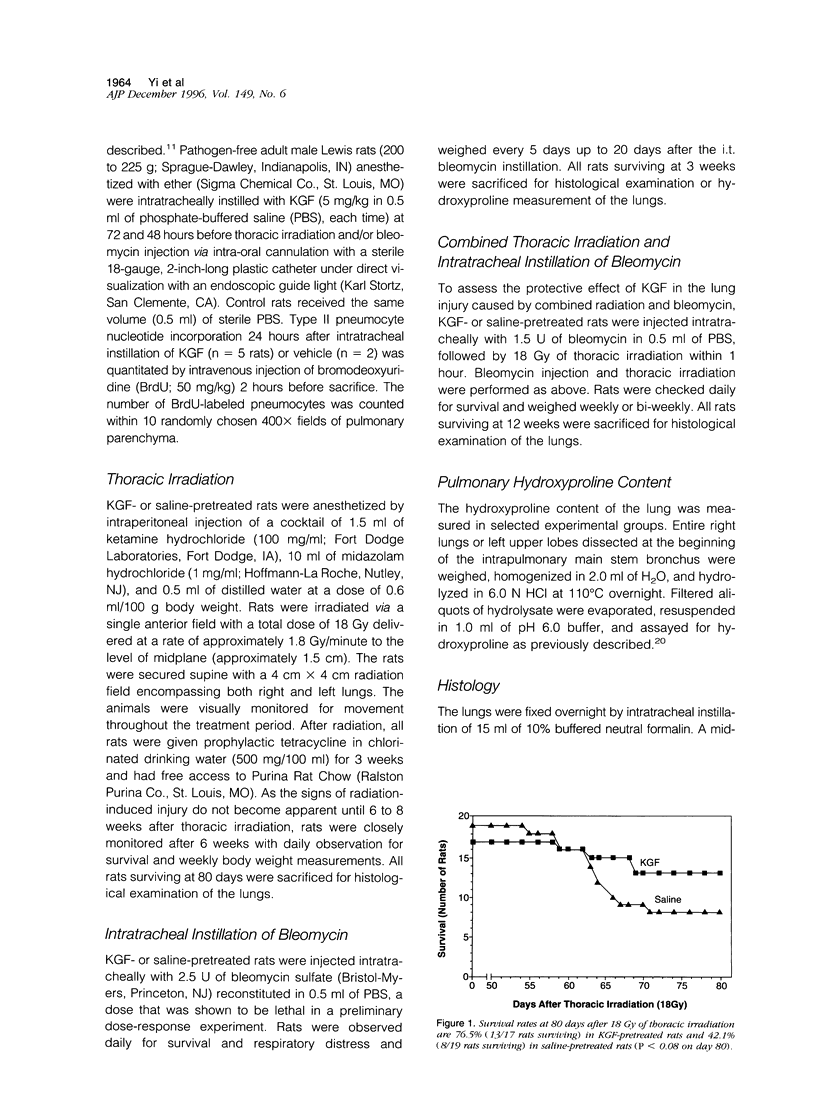Abstract
Keratinocyte growth factor (KGF) is a growth factor for type II pneumocytes. Type II pneumocyte hyperplasia, a common reaction to lung injury, has been postulated to play an important role in lung repair. The potential protective effect of KGF was therefore studied in rat models of radiation- and bleomycin-induced lung injury. Intratracheal instillation of KGF (5 mg/kg) 72 and 48 hours before 18 Gy of bilateral thoracic irradiation did not significantly improve survival, although histology showed less pneumonitis and fibrosis in KGF-pretreated as compared with control-irradiated rats. Intratracheal pretreatment with KGF in rats receiving intratracheal bleomycin (2.5 U) improved survival at 3 weeks to 100% (20/20 rats) from 40% (8/20 rats) in controls. All KGF-pretreated rats receiving bleomycin were well at 3 weeks and without histological evidence of pulmonary fibrosis whereas the 8 surviving control rats exhibited severe respiratory distress. Finally, in the most lethal challenge to the lung, rats pretreated with intratracheal KGF or saline were challenged with a combination of bleomycin (1.5 U) and bilateral thoracic irradiation (18 Gy). KGF-pretreated rats did not begin to die or show signs of respiratory distress until 7 weeks, whereas all saline-pretreated control rats receiving radiation and bleomycin died within approximately 4 weeks with severe respiratory distress and weight loss. In conclusion, radiation- and bleomycin-induced pulmonary injury and respiratory death are ameliorated by KGF pretreatment, suggesting a protective role for KGF-induced type II pneumocyte proliferation in lung injury.
Full text
PDF







Images in this article
Selected References
These references are in PubMed. This may not be the complete list of references from this article.
- Adamson I. Y., Bowden D. H. The type 2 cell as progenitor of alveolar epithelial regeneration. A cytodynamic study in mice after exposure to oxygen. Lab Invest. 1974 Jan;30(1):35–42. [PubMed] [Google Scholar]
- Adamson I. Y., Young L., Bowden D. H. Relationship of alveolar epithelial injury and repair to the induction of pulmonary fibrosis. Am J Pathol. 1988 Feb;130(2):377–383. [PMC free article] [PubMed] [Google Scholar]
- Brauchle M., Angermeyer K., Hübner G., Werner S. Large induction of keratinocyte growth factor expression by serum growth factors and pro-inflammatory cytokines in cultured fibroblasts. Oncogene. 1994 Nov;9(11):3199–3204. [PubMed] [Google Scholar]
- Crouch E. Pathobiology of pulmonary fibrosis. Am J Physiol. 1990 Oct;259(4 Pt 1):L159–L184. doi: 10.1152/ajplung.1990.259.4.L159. [DOI] [PubMed] [Google Scholar]
- Finch P. W., Cunha G. R., Rubin J. S., Wong J., Ron D. Pattern of keratinocyte growth factor and keratinocyte growth factor receptor expression during mouse fetal development suggests a role in mediating morphogenetic mesenchymal-epithelial interactions. Dev Dyn. 1995 Jun;203(2):223–240. doi: 10.1002/aja.1002030210. [DOI] [PubMed] [Google Scholar]
- Finch P. W., Rubin J. S., Miki T., Ron D., Aaronson S. A. Human KGF is FGF-related with properties of a paracrine effector of epithelial cell growth. Science. 1989 Aug 18;245(4919):752–755. doi: 10.1126/science.2475908. [DOI] [PubMed] [Google Scholar]
- Haschek W. M., Reiser K. M., Klein-Szanto A. J., Kehrer J. P., Smith L. H., Last J. A., Witschi H. P. Potentiation of butylated hydroxytoluene-induced acute lung damage by oxygen. Cell kinetics and collagen metabolism. Am Rev Respir Dis. 1983 Jan;127(1):28–34. doi: 10.1164/arrd.1983.127.1.28. [DOI] [PubMed] [Google Scholar]
- Mason I. J., Fuller-Pace F., Smith R., Dickson C. FGF-7 (keratinocyte growth factor) expression during mouse development suggests roles in myogenesis, forebrain regionalisation and epithelial-mesenchymal interactions. Mech Dev. 1994 Jan;45(1):15–30. doi: 10.1016/0925-4773(94)90050-7. [DOI] [PubMed] [Google Scholar]
- Moseley P. L., Shasby D. M., Brady M., Hunninghake G. W. Lung parenchymal injury induced by bleomycin. Am Rev Respir Dis. 1984 Dec;130(6):1082–1086. doi: 10.1164/arrd.1984.130.6.1082. [DOI] [PubMed] [Google Scholar]
- Panos R. J., Bak P. M., Simonet W. S., Rubin J. S., Smith L. J. Intratracheal instillation of keratinocyte growth factor decreases hyperoxia-induced mortality in rats. J Clin Invest. 1995 Oct;96(4):2026–2033. doi: 10.1172/JCI118250. [DOI] [PMC free article] [PubMed] [Google Scholar]
- Panos R. J., Rubin J. S., Csaky K. G., Aaronson S. A., Mason R. J. Keratinocyte growth factor and hepatocyte growth factor/scatter factor are heparin-binding growth factors for alveolar type II cells in fibroblast-conditioned medium. J Clin Invest. 1993 Aug;92(2):969–977. doi: 10.1172/JCI116673. [DOI] [PMC free article] [PubMed] [Google Scholar]
- Panos R. J., Suwabe A., Leslie C. C., Mason R. J. Hypertrophic alveolar type II cells from silica-treated rats are committed to DNA synthesis in vitro. Am J Respir Cell Mol Biol. 1990 Jul;3(1):51–59. doi: 10.1165/ajrcmb/3.1.51. [DOI] [PubMed] [Google Scholar]
- Rosiello R. A., Merrill W. W. Radiation-induced lung injury. Clin Chest Med. 1990 Mar;11(1):65–71. [PubMed] [Google Scholar]
- Sugahara K., Rubin J. S., Mason R. J., Aronsen E. L., Shannon J. M. Keratinocyte growth factor increases mRNAs for SP-A and SP-B in adult rat alveolar type II cells in culture. Am J Physiol. 1995 Sep;269(3 Pt 1):L344–L350. doi: 10.1152/ajplung.1995.269.3.L344. [DOI] [PubMed] [Google Scholar]
- Thet L. A., Parra S. C., Shelburne J. D. Sequential changes in lung morphology during the repair of acute oxygen-induced lung injury in adult rats. Exp Lung Res. 1986;11(3):209–228. doi: 10.3109/01902148609064297. [DOI] [PubMed] [Google Scholar]
- Ulich T. R., Yi E. S., Longmuir K., Yin S., Biltz R., Morris C. F., Housley R. M., Pierce G. F. Keratinocyte growth factor is a growth factor for type II pneumocytes in vivo. J Clin Invest. 1994 Mar;93(3):1298–1306. doi: 10.1172/JCI117086. [DOI] [PMC free article] [PubMed] [Google Scholar]
- Werner S., Peters K. G., Longaker M. T., Fuller-Pace F., Banda M. J., Williams L. T. Large induction of keratinocyte growth factor expression in the dermis during wound healing. Proc Natl Acad Sci U S A. 1992 Aug 1;89(15):6896–6900. doi: 10.1073/pnas.89.15.6896. [DOI] [PMC free article] [PubMed] [Google Scholar]
- Witsch I. H. Proliferation of type II alveolar cells: a review of common responses in toxic lung injury. Toxicology. 1976 Mar;5(3):267–277. doi: 10.1016/0300-483x(76)90046-9. [DOI] [PubMed] [Google Scholar]
- Witschi H. Role of the epithelium in lung repair. Chest. 1991 Mar;99(3 Suppl):22S–25S. doi: 10.1378/chest.99.3_supplement.22s. [DOI] [PubMed] [Google Scholar]







